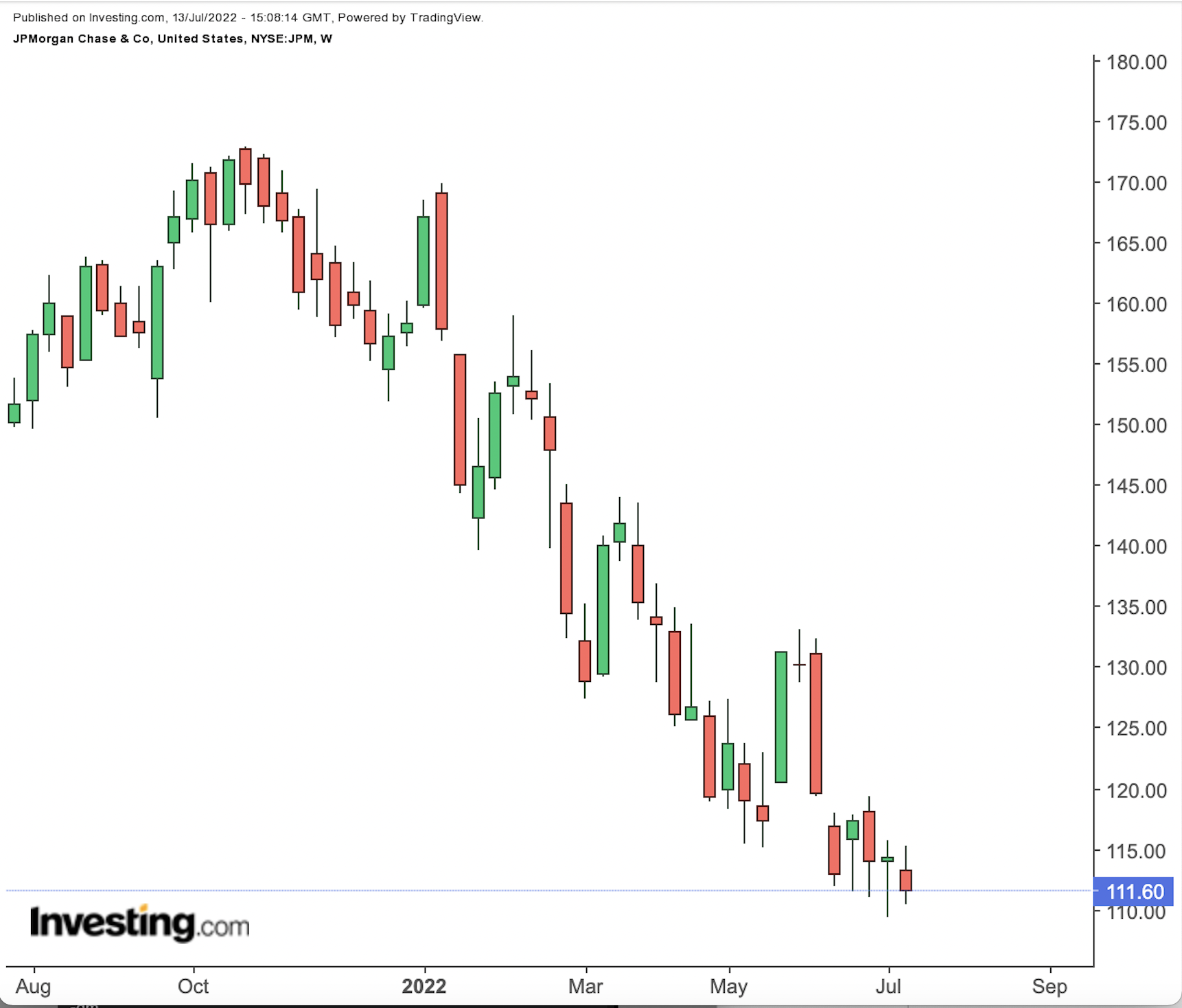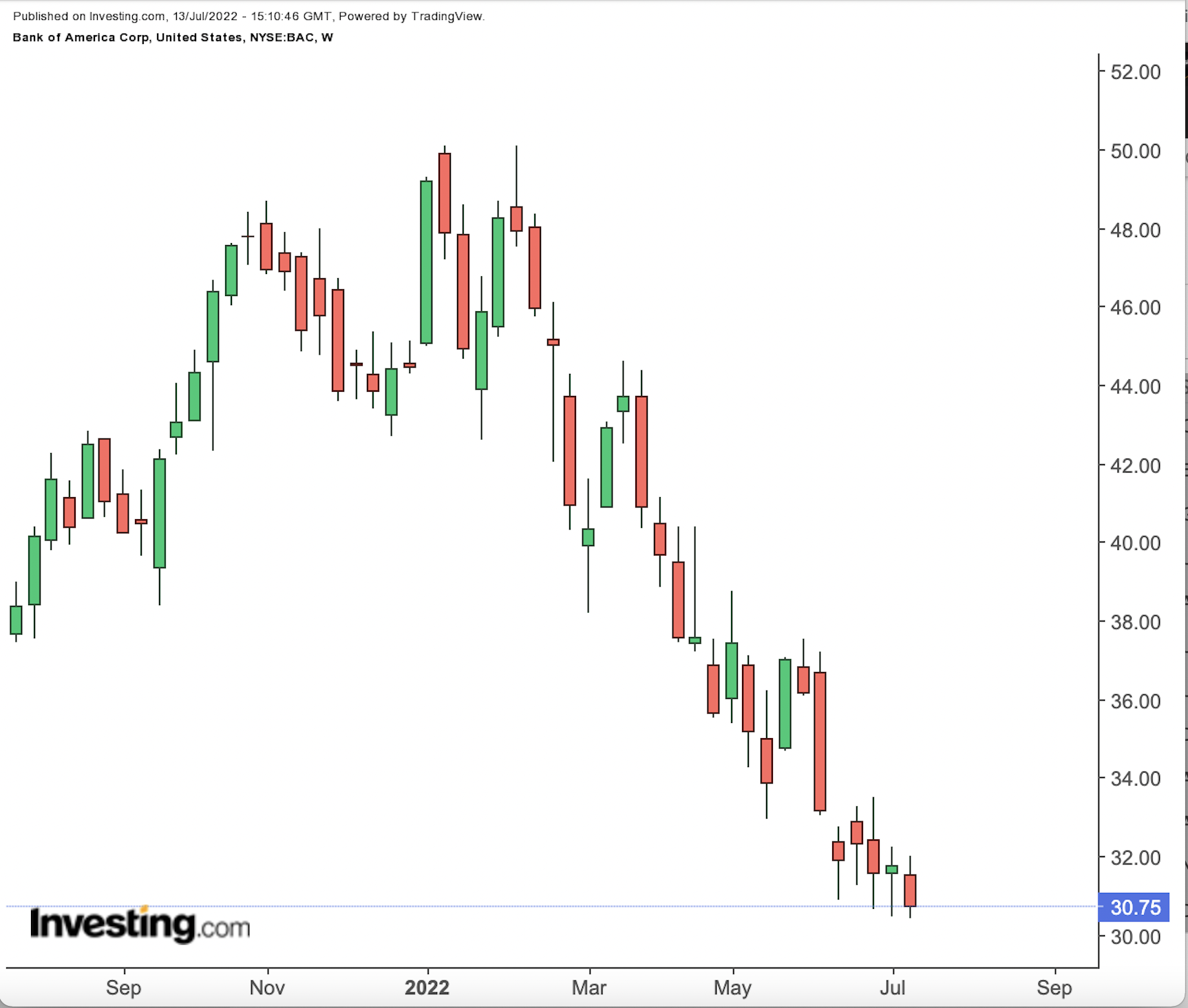- Banks are forecast to report lower earnings amid higher inflation and recession risk
- The KBW Bank Index has shed about 23% so far this year, underperforming the S&P 500
- Some banks may report strong gains as volatility spikes
With the second-quarter 2022 earnings season kicking off this week, results from top U.S. banks may show they are benefiting from the market volatility in stocks, bonds and commodities, boosting their trading income at a time when other avenues to make money are shrinking.
JPMorgan Chase & Co. (NYSE:JPM) and Morgan Stanley (NYSE:MS) are scheduled to report their earnings tomorrow, followed by Wells Fargo & Co. (NYSE:WFC) and Citigroup (NYSE:C) on Friday, and Bank of America Corp. (NYSE:BAC) and Goldman Sachs Group Inc. (NYSE:GS) next week.
At JPMorgan, trading revenue is expected to rise 15% to 20%, executives said in May. Citigroup expects trading revenue to jump more than 25%.
In addition to higher income from trading divisions, banks will also gain from the Federal Reserve’s drive to aggressively hike interest rates to fight inflation, which is running at the highest pace in four decades.
Banks generally make more money on their lending products when interest rates move higher. Markets are now predicting another 75-basis-point jump in the Fed rate late this month after the latest U.S. report showed that the rate of inflation in June rose 9.1% from a year earlier, the largest gain since the end of 1981.
These two tailwinds, however, have failed to excite investors about banking stocks, which have lost their lure this year amid fears of a recession. This could reduce demand for credit and force some borrowers to default on their obligations.
The KBW Bank Index has shed about 23% so far this year, underperforming the S&P 500 Index, which is down about 20% during the same period.
Drop In Investment Banking
Even with the boost from trading and interest income, bank earnings are expected to be broadly lower when compared with the same period a year ago, when these lenders were in a great shape, mostly due to acceleration in mergers and acquisitions and other investment banking businesses.
Investment-banking revenue may have sunk 44% in the second quarter from a year earlier, according to analysts’ estimates by Bloomberg. Analysts are expecting a 74% drop in revenue from equity issuance, a 36% decline from debt issuance and a 16% slump from advising on mergers and acquisitions.
A year ago, banks were also able to fuel their earnings by releasing some of the money they had set aside for what they feared would be a wave of bad loans during the pandemic.
With these two factors no more in play, the six largest U.S. banks are expected to report $27.2 billion in combined profits for the second quarter, according to FactSet, down 10% from the first quarter and down 35% from a year earlier.
A Buying Opportunity
While bank earnings overall may disappoint, the general economic environment is still supportive, especially when consumer spending and job creation remain strong. Some analysts believe that the recent sell-off in bank stocks is already factoring in the risks they face, and some banks are offering a good entry point.
Analysts at Citi upgraded JPMorgan this week to buy from neutral, citing solid fundamentals that should appeal to investors, after JPM stock declined 30% this year.
The note says:
“We are upgrading JPM to buy as we believe investors will first look to high-quality franchises with strong management teams and a sound balance sheet, and we believe JPM fits this narrative. Given the YTD pull back in the stock, we believe the market is no longer reflecting a premium valuation, and we view this as an attractive entry point.”

Source: Investing.com
Citi analysts don’t see banks facing capital issues in this down cycle given less credit creation plus the benefit of higher rates.
Said Citi:
“We don’t see a near-term catalyst, but believe the stocks will reprice quickly once the market gains comfort that there is less balance sheet risk than feared.”
Bank of America is another stock trading at an attractive level after it lost about 30% of its value this year. Wells Fargo, while reiterating its overweight rating on the stock, said in a recent note that BAC stock price is promising even after pricing in a recession.
“We reiterate our overweight rating on BAC and see a favorable reward-to-risk scenario of at least 3-to-1 and a weighted average return for the stock of up 40%, assuming a one-third chance of recession,” the note said.

Source: Investing.com
Wells Fargo has a $66 price target on Bank of America, which traded on Wednesday at $30.77.
Disclosure: The writer doesn’t own shares of the companies mentioned in this article.
